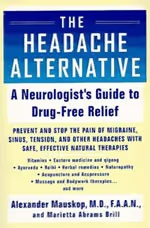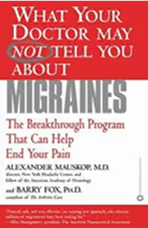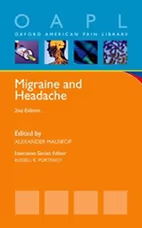Daily Headache
Chronic daily headache (CDH) is a very common type of headache. It occurs in 4-5% of the population, and is the leading problem seen in headache practices. In the United States, up to 80% of patients seen in headache clinics have chronic daily headache. As the name implies, CDH refers to headaches that are present very frequently, usually on more than 15 days per month. The subtypes are Chronic Migraine, Chronic Tension-Type Headache, New Daily Persistent Headache, Chronic Cluster Headache, Hemicrania Continua, Chronic Paroxysmal Hemicrania and Medication-Overuse Headache.
The most common cause of CDH is medication overuse. The regular use of caffeine-containing drugs (Excedrin, Anacin, Fioricet, Fiorinal, Esgic and other), barbiturates (Fiorinal, Fioricet, Esgic) and narcotics (Vicodin, Percocet, Tylenol with codeine, Oxycontin). Triptans, such as sumatriptan (Imitrex), rizatriptan (Maxalt) and other do not cause rebound or medication overuse headaches. Taking aspirin actually can reduce the chances of developing chronic migraine. Many patients with CDH report that though they initially had only occasional migraines, they began having persistent low-grade daily headaches as they increased their medication use. As the headache frequency increased, the acute medications (with caffeine, butalbital, or narcotics) seemed to become less and less effective. This happens because the acute medications are short-acting, and as the effect of one dose wears off a withdrawal syndrome occurs, triggering another headache and the need to take more medication. This pattern becomes a vicious cycle of daily headaches and frequent, albeit ineffective, medication intake. Furthermore, the overuse of acute medication makes the headaches refractory to treatment with preventative agents. The most effective way of preventing CDH is to limit the use of these medications to a total of 1 – 2 times per week. Again, even though many doctors believe that triptans, aspirin, ibuprofen and naproxen can also cause medication overuse headaches, there is no evidence to support this claim.
Other factors that have been associated with CDH include stressful life events, emotional abuse, obesity, head injury, excessive caffeine consumption, snoring, and low socioeconomic status.
Treatment of CDH depends on what subtype you have. Botox is an FDA-approved treatment for chronic migraines and it is highly effective and is safer than any medication taken by mouth. Medication overuse is treated by stopping overused medications. Getting Botox injections first may make this process easier. You will usually be given a triptan or another medicine to make withdrawal easier. It may take a month or longer before detoxification from the acute medication is complete and headaches improve. Patients who continue to have daily headaches despite stopping overused medications may require daily preventative medications. Non-drug therapy also plays a role in the treatment of CDH. Acupuncture, biofeedback, relaxation training and cognitive-behavioral therapy can be very effective, particularly when used in conjunction with medications. Two rare types of daily headache, chronic paroxysmal hemicrania and hemicrania continua are treated with indomethacin, which provides very dramatic relief. Magnesium, feverfew, coenzyme Q10 and other supplements can also help. We see many patients who obtain complete relief of their headaches after they receive an infusion of magnesium.
.jpg)



This “book” appears to have largely been born out of his blog from the New York Headache Center. For years, he has regularly put up information, scientific and clinical, for his headache followers. He has created this “book,” actually an e-book, which takes relevant information from his experience and knowledge of migraine. There is no need for an index and chapter references. He uses hyperlinks, embedded in the e-book, to connect to material online, which he puts in context for the reader. This works very well as one hyperlink may go to an original paper or publication or a resource site.
He links to major medical journals including headache journals and his own publications, when helpful, as well as nonmedical literature and other sites. This format allows the e-book to be updated from time to time, which is easy to do with this approach.
The book has a very interesting introduction and deals with evidence-based medicine and its role in migraine therapy. When he begins the section on 150+ treatments, he starts with a very interesting comment. Many of the treatment ideas that I describe in this book are not just off-label (that is, not approved by the FDA) but may appear to be off-the-wall. It is refreshing to hear such intellectual honesty from a practicing neurologist.
There is a great section on supplements and finding someone to help with your migraine, such as coach, a partner, or a sympathetic friend. A diagnostic discussion follows and is most helpful, as proper diagnosis directs treatment, as are the detailed sections on triggers including environment, food, exercise, physical therapies, and sleep. Herbal therapies are covered as is neuromodulation and injections/blocks among others.
In the sections on drugs, he deals with acute therapies and the modern use of triptans and gepants, and a ditan. Preventive therapies start with monoclonal calcitonin gene-related peptide antibodies, tricyclic medications, and many other preventive therapies including beta blockers, anti-seizure drugs, nonsteroidal anti-inflammatory drugs, and botulinum injections. From acupuncture to Feldenkrais methods, he covers the contemporary plethora of migraine “treatments” as he sees it in practice.
He ranks all medications on a 1 to 10 scale regarding his own subjective opinions of the utility of each treatment. He indicates that no treatment gets 10 as a score and any receiving a score of 1 were not rated. He also lists his favorite migraine therapies separately. He includes a lot of data links here, from single case reports to full-scale randomized clinical trials, and detailed reviews. His clinical acumen shines through the volume and one gets the impression that this is a very personal view at times, not always backed by evidence, as there may not be any, but by experience, practice and pragmatism. He carefully notes the general things to be careful of in taking some treatments and warns if there are serious concerns. Nonetheless, he indicates clearly that the advice of a medical professional should be sought before trying the therapies mentioned.
Diagnosing secondary headache that can mimic migraine or vice versa is a useful section but does not go into depth about the disorders/diseases mentioned, as this is not the intention of the book. Special circumstances are given sections including menstrual migraine, pregnancy, resistant/refractory headache, aura and headache, and many others.
The author is a senior, highly experienced neurologist and has a high degree of interest in migraine and other headache disorders. He has a sense of curiosity about the brain and migraine and that comes through to the reader of this small volume. I count 23 endorsements, including the excellent foreward of the book from a wide range of well-known people, which includes two prior editors of this journal. He is well liked and highly respected by his colleagues.
In many ways, this book does what online databases on diseases cannot do most times. He tells the reader what he knows and how to use that knowledge. He directs the novice and experts to the right literature and takes the reader on a personal journey through the field of migraine treatments. He tells people, “…keep seeking relief, not to give up on or blame yourself for the pain you experience from migraine.”
There is a printed version of the book; however, the e-book is ideal for the intended purpose. I would recommend it the first instance. It is available via a commercial site and inexpensive.
I would recommend this book to anyone who has migraine or cares for people with migraine and wants a broad and sometimes detailed overview of the treatments. Available in the e-book format, it represents a lot of work for one person, but his passion, occasional humor, and historical perspectives are evident in this work. You don’t have to agree or accept everything the author says to enjoy and benefit from this “book,” and I know he would want people to be critical and skeptical where warranted. However, you will find more than you would usually need to know from this banquet of 150 ways to help your migraines! Enjoy, I did very much. Read it through once and save as reference.
Alexander Mauskop, Director of the New York Headache Center, and Marietta Abrams Brill, a freelance medical writer, have written principally for headache sufferers in North America. They answer questions like “is Rolfing covered by medical insurance?”, and include an excellent resource section in the back. of the book which lists American organizations for the various therapies. But they provide enough background information on both headache and alternative treatments to make their book interesting to readers from other countries, too. In covering most of the more common alternative therapies~like herbs, acupuncture, massage, Ayuverda and Eastern medicine, and qigong-they aim to inform rather than judge, cite research evidence where it exists, and point to potential dangers as well as benefits.
Each of the 10 chapters is introduced with a pithy quote: “Divine is the work to subdue pain” (Hippocrates) heads the first chapter. After general background on pain theories and headache diagnosis, common alternative approaches are covered in turn and there is, of course, oodles of advice on diet and nutrition. A helpful glossary guides readers through words that conventional doctors are familiar with, like Scotoma, and those with which we aren’t, like Qi, Vatta, and Pitta. To round off, a comprehensive resource section and selected bibliography give useful directions to readers wanting more information about specific therapies.
Like all good guides, this one follows a logical structure and so it is relatively simple to go quickly to the information you want to find. It is easy to read. All in all, it is a guide which headache sufferers looking for good information on alternative therapies can be thankful for.
